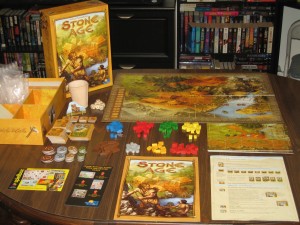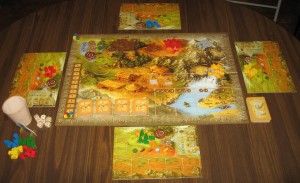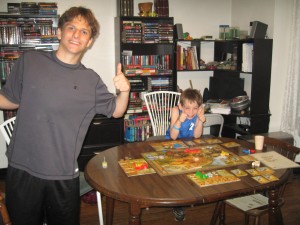I’ve reviewed a few worker placement games already…Lords of Waterdeep and Agricola, for example. For those of you new to the genre, worker placement games task players with strategically placing (you guessed it) workers around the board in various places in order to gain resources and other bonuses. The kinds of resources you can acquire in this fashion vary from game to game, but you’re ultimately using said resources to perform other actions and ultimately trying to score more points than everyone else.
Stone Age is no stranger to these gameplay mechanics. You’ll be collecting resources like food, wood, brick, stone, and gold with your workers and using / trading those resources in to feed your workers and acquire various buildings and civilization cards. Let’s take a quick look at what comes in the box, along with a brief overview of the gameplay mechanics before heading into the review.
Components
Resources – These are what your workers will be collecting in order for you to purchase the items that will earn you points. Food is collected in this manner as well in order to feed your workers.
Workers – Players will be assigning these to different spots on the board in order to perform different actions.
Markers – There are two square markers of each color, one large and one small. One is used to keep score on the score track while the other is used to keep track of how far a player has moved up the farming track.
Tool Tiles – Players can collect these when assigning workers. They add value to your die rolls in order to give players an edge when collecting resources.
Building Tiles – These are purchasable via resources and provide players with points, which are accounted for immediately.
Civilization Cards – These are purchasable via resources and provide players with both an immediate bonus as well as factor in to end game scoring.
Starting Player Figure – This cardboard piece serves to remind players with who the current player is. After a round is over, the starting player figure moves to the next person clockwise.
Player Boards – Each player receives one of these, which serves as a home base for buildings, food, workers, tools, and resources that they may have acquired.
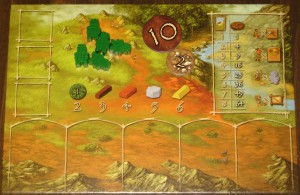
Purchased buildings go along the bottom, tools on the left, and resources, food, and workers in the middle. The key on the right will assist players during end game scoring.
Setup & Gameplay
Each player starts with a player board, twelve food, and five workers. The main board is seeded with resources, food, tools, stacks of building tiles, and civilization cards. Both of the square markers should be on their “0” spaces, one on the score track and one on the farm track. The number of building tile stacks will vary, depending on how many players are playing the game. Select a starting player at random and give them the starting player figure.
Each round is made up of three phases, which can be summarized as follows:
1. Worker Placement – The starting player for that round begins by placing one or more of his workers on ONE of the spaces on the board. Players continue doing this, going clockwise, until everyone is out of workers.
2. Worker Actions – The starting player takes the actions that his/her workers are on. Unlike phase one, the starting player will resolve ALL of the actions from ALL of their workers before the next player’s turn. Once the starting player has resolved all of their worker actions, the next player does so, going around the board clockwise. Players may choose in what order they resolve actions.
3. Feed Workers – Each player must trade in one food per worker. They can substitute a resource to “pay” for food if they don’t have enough food tokens. Otherwise, they lose ten points immediately.
A note regarding the collection of resources & hunting for food in phase two:
Collecting resources and hunting for food is done using die/dice rolls. Players take the same number of dice as there are workers belonging to them in that location, roll them, and divide by a fixed number. The more valuable the resource, the higher the denominator.
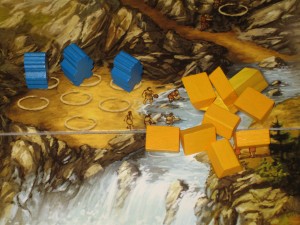
Gold is the hardest resource to acquire, but can score a player a lot of points when used to build certain buildings.
A note regarding civilization cards:
There are four spaces on the board for four civilization cards. Above each slot is a resource cost of one through four. Cards that aren’t purchased in a round slide toward the cheaper resource card slots, making them more appetizing than they previously were. The top part of these cards give the player an immediate bonus upon being purchased, whereas the bottom part of the card is used in final scoring.
Scoring
Players will be earning points throughout the game, but also earn points at the very end of the game. Game end occurs when one building stack is empty or there aren’t enough civilization cards left to cover all four slots.
Civilization cards have various bonuses on the bottom of them. Some reward players points for every worker they have while others reward players for every building that they have. Some civilization cards have culture symbols on them, rewarding players exponentially for every different culture symbol in their possession.
Whoever has the most points after scoring is all said and done wins the game.
I realize that I skipped over some things (possible worker actions, for example), I did this to keep the review moving. Interested parties can find the rules here should they wish more information: Stone Age Manual.
The Review
For as simple as the round phases are, there is a lot of strategy and depth. The civilization cards provide different ways to score, allowing players to specialize in particular areas. If your farming score is high on the track, for example, you may want to pick up as many civilization cards that provide bonuses for farming. Players can opt out of civilization cards altogether and buy out as many buildings as they can in the hopes that they can score a ton of immediate points and end the game quickly by exhausting one of the building stacks. There is some luck involved since the value of your dice rolls determine how many resources you collect, though tools can help to offset that a little. Some may be turned off by the luck factor, especially if dice in general normally holds a grudge against a particular person. Yahtzee and I, for example, have a hate-hate relationship.
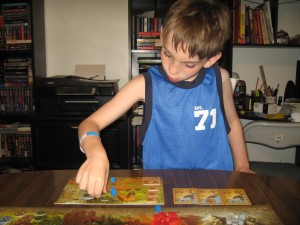
Being forced to trade in resources for food because of a bad dice roll can really set you back. Make sure you have enough food by assigning extra workers to hunt!
The components are very well done and easy on the eyes. The dice cup was a nice touch. I had enough baggies to hold everything by category separately, so no complaints there either. The board itself is fairly easy to follow, once you get accustomed to how each worker area operates. The rules do an excellent job in explaining how it all comes together and includes a separate sheet that serves as a guide for the various civilization card types.
The kids enjoyed playing the game and I enjoyed watching them try to figure out how they wanted to earn their points. Anthony (16) concentrated on buying / constructing buildings and scoring immediate points and quickly took the lead. Vinnie Jr (11) struggled in the beginning with food, but managed to get lucky rolls and feed his people despite the odds and earn himself a few civilization cards and a few buildings. I bought out civilization cards almost every turn, while bringing my farming up to 10 food per turn and bringing my population up to 10. I was in the position to not worry about food, and soon had myself a nice stack of civilization cards that pushed me ahead in the end. Each of us had our own strategy and it was neat to see how it all came to its conclusion.
Oh, and those who hate math with a passion may want to steer clear or play with someone who is willing to do all the legwork. You’ll be doing a lot of multiplication and division, and finding answers to the lowest whole number. Not a problem for a crack accountant like myself, and it was even educational for the kids. As a father and a math guru, I approve of this particular gameplay mechanic.
Stone Age is an excellent way to introduce new players to the worker placement genre, though newcomers should be aware that there is a small learning curve to overcome. Experienced players of the genre will be able to jump right in after a quick rules primer. All in all, this game would make an excellent addition to your family game night rotation, just be aware that it can take an hour or two to play.
Final Verdict: 8/10

